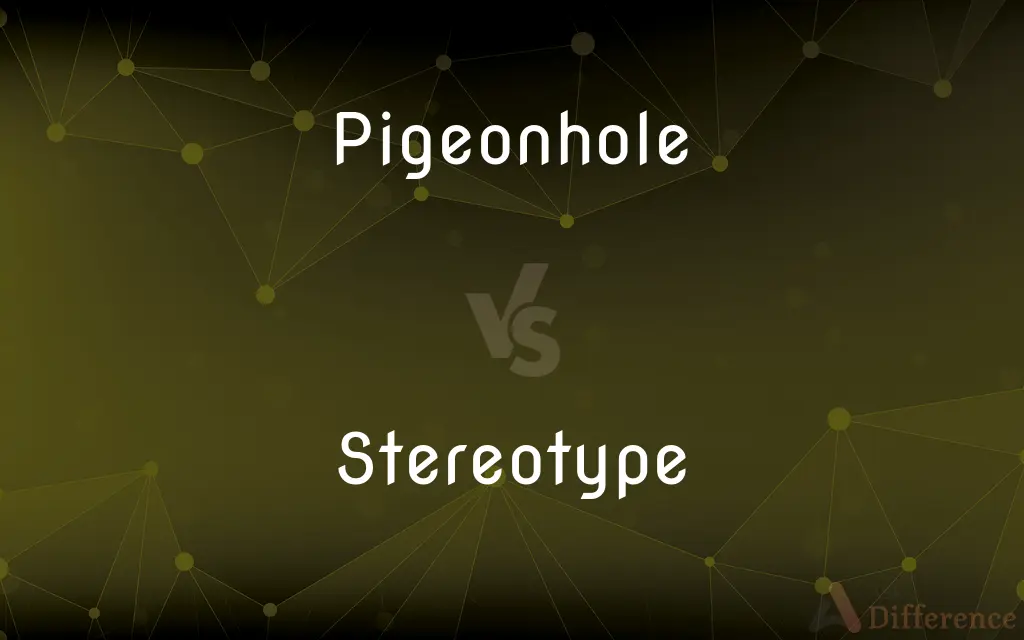Pigeonhole vs. Stereotype — What's the Difference?

Difference Between Pigeonhole and Stereotype
ADVERTISEMENT
Compare with Definitions
Pigeonhole
A small compartment or recess, as in a desk, for holding papers; a cubbyhole.
Stereotype
In social psychology, a stereotype is a generalized belief about a particular category of people. It is an expectation that people might have about every person of a particular group.
Pigeonhole
A specific, often oversimplified category.
Stereotype
A widely held but fixed and oversimplified image or idea of a particular type of person or thing
Sexual and racial stereotypes
The stereotype of the woman as the carer
Pigeonhole
The small hole or holes in a pigeon loft for nesting.
ADVERTISEMENT
Stereotype
A relief printing plate cast in a mould made from composed type or an original plate.
Pigeonhole
To place or file in a small compartment or recess.
Stereotype
View or represent as a stereotype
The city is too easily stereotyped as an industrial wasteland
Pigeonhole
To classify mentally; categorize.
Stereotype
A conventional, formulaic, and oversimplified conception, opinion, or image.
Pigeonhole
To put aside and ignore; shelve.
Stereotype
One that is regarded as embodying or conforming to a set image or type.
Pigeonhole
One of an array of compartments for housing pigeons.
Stereotype
(Printing) A metal printing plate cast from a matrix molded from a raised printing surface, such as type.
Pigeonhole
(by extension) One of an array of compartments for receiving mail and other messages at a college, office, etc.
Fred was disappointed to find his pigeonhole empty except for bills and a flyer offering 20% off on manicures.
Stereotype
To make a stereotype of.
Pigeonhole
One of an array of compartments for storing scrolls at a library.
Stereotype
To characterize by a stereotype
"Elderly Americans are the neglected sector of the fashion industry, stereotyped by blue hair and polyester pantsuits" (American Demographics).
Pigeonhole
A similar compartment in a desk, used for sorting and storing papers.
Stereotype
To give a fixed, unvarying form to.
Pigeonhole
(figurative) A category.
Stereotype
To print from a stereotype.
Pigeonhole
To categorize; especially to limit or be limited to a particular category, role, etc.
Fred was tired of being pigeonholed as a computer geek.
Stereotype
A conventional, formulaic, and often oversimplified or exaggerated conception, opinion, or image of (a person or a group of people).
Pigeonhole
To put aside, to not act on (proposals, suggestions, advice).
Stereotype
(psychology) A person who is regarded as embodying or conforming to a set image or type.
Pigeonhole
A small compartment in a desk or case for the keeping of letters, documents, etc.; - so called from the resemblance of a row of them to the compartments in a dovecote.
Stereotype
(printing) A metal printing plate cast from a matrix moulded from a raised printing surface.
Pigeonhole
To place in the pigeonhole of a case or cabinet; hence, to put away; to lay aside indefinitely; as, to pigeonhole a letter or a report.
Stereotype
(software engineering) An extensibility mechanism of the Unified Modeling Language, allowing a new element to be derived from an existing one with added specializations.
Pigeonhole
A specific (often simplistic) category
Stereotype
(transitive) To make a stereotype of someone or something, or characterize someone by a stereotype.
Pigeonhole
A small compartment
Stereotype
To prepare for printing in stereotype; to produce stereotype plates of.
To stereotype the Bible
Pigeonhole
Place into a small compartment
Stereotype
To print from a stereotype.
Pigeonhole
Treat or classify according to a mental stereotype;
I was stereotyped as a lazy Southern European
Stereotype
To make firm or permanent; to fix.
Stereotype
A plate forming an exact faximile of a page of type or of an engraving, used in printing books, etc.; specifically, a plate with type-metal face, used for printing.
Stereotype
The art or process of making such plates, or of executing work by means of them.
Stereotype
To prepare for printing in stereotype; to make the stereotype plates of; as, to stereotype the Bible.
Stereotype
Fig.: To make firm or permanent; to fix.
Powerful causes tending to stereotype and aggravate the poverty of old conditions.
Stereotype
A conventional or formulaic conception or image;
Regional stereotypes have been part of America since its founding
Stereotype
Treat or classify according to a mental stereotype;
I was stereotyped as a lazy Southern European
Share Your Discovery

Previous Comparison
Distrust vs. Suspicion
Next Comparison
Accession vs. Accretion













































